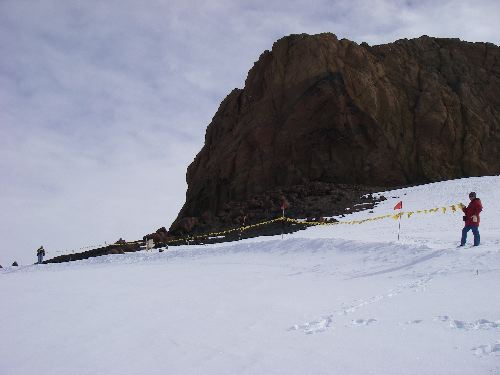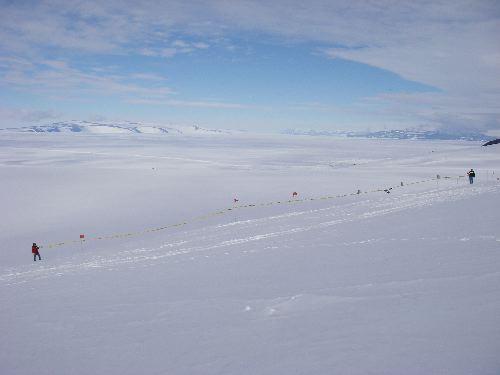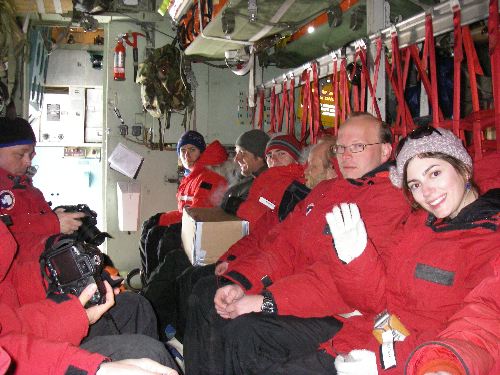Exploring McMurdo
For me, the reoccurring theme of this 2 month adventure has been, "Just when you thought it could not get better….”. As we walked off the Oden on Jan 12 we were told that our flight home would be delayed for one more day and we would not leave until the 14th. This meant that we had an extra day to explore the historic and interesting area around McMurdo. Our first stop was our dorm room. Although I was suddenly sharing a room with 4 others, the beds were fine and the food was great. On our first evening we had a chance to tour Scott’s Discovery Hut which was built over 100 years ago by Robert F. Scott and later it was used by some of the other early Antarctic explorers. The most fascinating thing about he hut is that because the climate is so cold and dry, decay is extremely slow. The wooden building is still quite sound and inside the belongings of some of the expeditions are still intact after a century.


The next morning I attended a training meeting in order to qualify to go on the most interesting hike in the area. About 11am I joined Dr. Henrik Kylin from Sweden and Dr. Xiaojun Yuan from Columbia University on a 7-mile hike to Castle Rock. The hike took us out of McMurdo and up onto two of the glaciers nearby. Everything on Ross Island is either volcanic rock or glacial ice and this hike gave us the chance to explore both. After filing a hike plan with the emergency office we were issued a portable radio and off we went. The landscape was very odd. Brown and black volcanic rock was weathered into what looked like soil but there was almost no organic matter in it. You cannot find a tree or a blade of grass or even moss anywhere. And then the trail turned to an ice path up onto the glacier. Bamboo poles with wildly flapping flags were driven into the ice every 50 feet to mark the trail and to keep us on safe ice. After a steady uphill hike for about 3 miles, we reached the barren pinnacle of Castle Rock and stopped for lunch. Of course, after 7 weeks on a Swedish IcebreakerAn icebreaker is a special purpose ship or boat designed to move and navigate through ice-covered waters. I now refer to coffee/snack breaks as Fikas.


Our group of three then turned right and hiked down another glacier and headed for the sea ice. Our goal was about 4 miles away at Ross Base, operated by New Zealand. I have always been a fan of sled riding and the next 1 mile of trail had the most amazing potential for sledding that I have ever seen. Smooth, solid, glacial ice, covered with 3 inches of powdery snow, all downhill for 1 mile until it reached the frozen sea. There were no trees or rocks or even level areas to slow you down. In fact, I kept thinking that if you started at Castle Rock on a sled, you would be going so fast after the first 100 yards that you would be unable to stop for the full 1 mile run.





Flying Off the Ice
The next morning we were all taken to the airport for our flight to New Zealand. It is important to point out the like everything else in Antarctica, it was unique. The shuttle bus was a vehicle I had read about for years. Ivan the Terra Bus has huge tires that allow it to drive many miles out onto the sea ice and the glaciers to each of the 3 seasonal airfields. All of the airstrips are on ice and the flight takes about 8 hours. First the cargo is loaded into the open back of the C-130 Hercules and then the humans get to sit on benches made of nylon webbing. The plane has little insulation so we were required to wear our extreme cold weather clothing and earplugs during the flight. Once we were in the air, many of us were able to walk around inside the cargo storage area of the plane and some took naps on top of the luggage. I was able to get a tour of the cockpit and I had a nice chat with the New Zealand crew as they explained how they use the original equipment 1965 instrument panels. It was like flying in a fully functioning antique.




After 8 hours we had flown from Antarctica to another planet. For the first time since Thanksgiving, I saw trees and grass and green. As the door of the plane opened, we could all smell the sweet air of summer flowers. That evening, most of us sat outside for dinner and watched the sun go down and the stars shine for the first time in 7 weeks. Then I found an old friend in the sky. There was the constellation Orion the Hunter with his 3 star belt. I have looked up at this constellation my whole life but this was the first time I had ever seen it in the Northern sky and Orion was standing on his head!
Take care, have fun & make memories,
Jeff Peneston


Comments